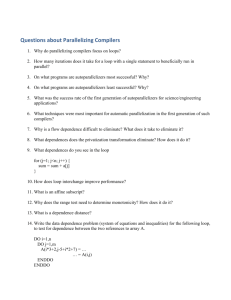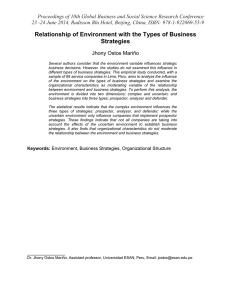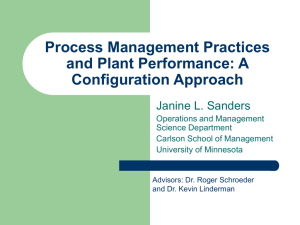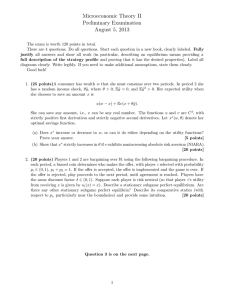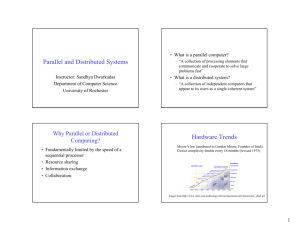Prospector: A Dynamic Data-Dependence Profiler To Help Parallel Programming Minjang Kim Hyesoon Kim
advertisement
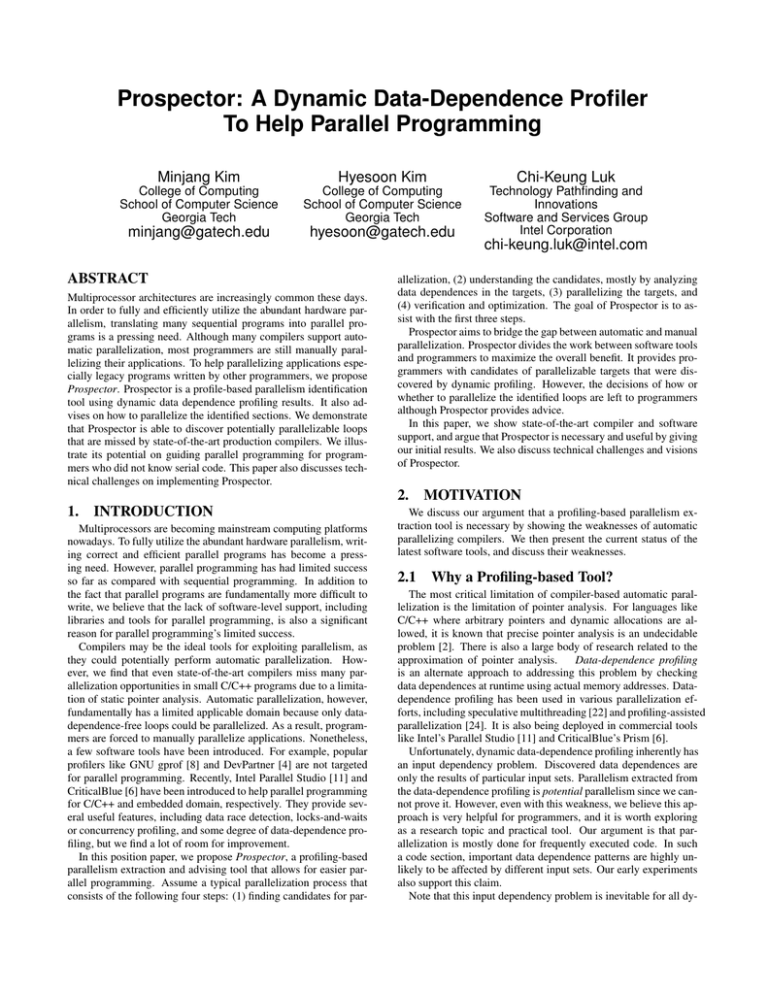
Prospector: A Dynamic Data-Dependence Profiler
To Help Parallel Programming
Minjang Kim
Hyesoon Kim
Chi-Keung Luk
College of Computing
School of Computer Science
Georgia Tech
College of Computing
School of Computer Science
Georgia Tech
minjang@gatech.edu
hyesoon@gatech.edu
Technology Pathfinding and
Innovations
Software and Services Group
Intel Corporation
ABSTRACT
Multiprocessor architectures are increasingly common these days.
In order to fully and efficiently utilize the abundant hardware parallelism, translating many sequential programs into parallel programs is a pressing need. Although many compilers support automatic parallelization, most programmers are still manually parallelizing their applications. To help parallelizing applications especially legacy programs written by other programmers, we propose
Prospector. Prospector is a profile-based parallelism identification
tool using dynamic data dependence profiling results. It also advises on how to parallelize the identified sections. We demonstrate
that Prospector is able to discover potentially parallelizable loops
that are missed by state-of-the-art production compilers. We illustrate its potential on guiding parallel programming for programmers who did not know serial code. This paper also discusses technical challenges on implementing Prospector.
allelization, (2) understanding the candidates, mostly by analyzing
data dependences in the targets, (3) parallelizing the targets, and
(4) verification and optimization. The goal of Prospector is to assist with the first three steps.
Prospector aims to bridge the gap between automatic and manual
parallelization. Prospector divides the work between software tools
and programmers to maximize the overall benefit. It provides programmers with candidates of parallelizable targets that were discovered by dynamic profiling. However, the decisions of how or
whether to parallelize the identified loops are left to programmers
although Prospector provides advice.
In this paper, we show state-of-the-art compiler and software
support, and argue that Prospector is necessary and useful by giving
our initial results. We also discuss technical challenges and visions
of Prospector.
2.
1.
INTRODUCTION
Multiprocessors are becoming mainstream computing platforms
nowadays. To fully utilize the abundant hardware parallelism, writing correct and efficient parallel programs has become a pressing need. However, parallel programming has had limited success
so far as compared with sequential programming. In addition to
the fact that parallel programs are fundamentally more difficult to
write, we believe that the lack of software-level support, including
libraries and tools for parallel programming, is also a significant
reason for parallel programming’s limited success.
Compilers may be the ideal tools for exploiting parallelism, as
they could potentially perform automatic parallelization. However, we find that even state-of-the-art compilers miss many parallelization opportunities in small C/C++ programs due to a limitation of static pointer analysis. Automatic parallelization, however,
fundamentally has a limited applicable domain because only datadependence-free loops could be parallelized. As a result, programmers are forced to manually parallelize applications. Nonetheless,
a few software tools have been introduced. For example, popular
profilers like GNU gprof [8] and DevPartner [4] are not targeted
for parallel programming. Recently, Intel Parallel Studio [11] and
CriticalBlue [6] have been introduced to help parallel programming
for C/C++ and embedded domain, respectively. They provide several useful features, including data race detection, locks-and-waits
or concurrency profiling, and some degree of data-dependence profiling, but we find a lot of room for improvement.
In this position paper, we propose Prospector, a profiling-based
parallelism extraction and advising tool that allows for easier parallel programming. Assume a typical parallelization process that
consists of the following four steps: (1) finding candidates for par-
chi-keung.luk@intel.com
MOTIVATION
We discuss our argument that a profiling-based parallelism extraction tool is necessary by showing the weaknesses of automatic
parallelizing compilers. We then present the current status of the
latest software tools, and discuss their weaknesses.
2.1
Why a Profiling-based Tool?
The most critical limitation of compiler-based automatic parallelization is the limitation of pointer analysis. For languages like
C/C++ where arbitrary pointers and dynamic allocations are allowed, it is known that precise pointer analysis is an undecidable
problem [2]. There is also a large body of research related to the
approximation of pointer analysis.
Data-dependence profiling
is an alternate approach to addressing this problem by checking
data dependences at runtime using actual memory addresses. Datadependence profiling has been used in various parallelization efforts, including speculative multithreading [22] and profiling-assisted
parallelization [24]. It is also being deployed in commercial tools
like Intel’s Parallel Studio [11] and CriticalBlue’s Prism [6].
Unfortunately, dynamic data-dependence profiling inherently has
an input dependency problem. Discovered data dependences are
only the results of particular input sets. Parallelism extracted from
the data-dependence profiling is potential parallelism since we cannot prove it. However, even with this weakness, we believe this approach is very helpful for programmers, and it is worth exploring
as a research topic and practical tool. Our argument is that parallelization is mostly done for frequently executed code. In such
a code section, important data dependence patterns are highly unlikely to be affected by different input sets. Our early experiments
also support this claim.
Note that this input dependency problem is inevitable for all dy-
Table 1: OmpSCR Automatic Parallelization Results
How many loops can compilers parallelize automatically?
Benchmark
#
ICC #
Reason
PGC #
Reason
FFT
2
1
Recursion
0
No benefit
FFT6
3
0
Pointers
0
No benefit
Jacobi
2
1
Pointers
0
Pointers
LUreduction
1
0
Pointers
0
Pointers
Mandelbrot
1
0
Reduction
0
Multi-exits
Md
2
1
Reduction
0
Pointers
Pi
1
1
N/A
0
No benefit
QuickSort
1
0
Recursion
0
No benefit
TOTAL
13
4
N/A
0
N/A
namic program analysis techniques. The majority of memory leaks
and data-race detectors are implemented as dynamic tools. Fixing all discovered memory leaks and races does not guarantee the
safety of the program. However, these tools are critical for successful and efficient software development. Our profile-based data
dependence analysis is also based on the same premise. Since manual parallelization is so painful for many programmers, hints from
Prospector on where and how to parallelize should be helpful.
2.2
Automatic Parallelization in C/C++
This section briefly summarizes the weaknesses of automatic
parallelization of the two latest production compilers, which provides the motivation for using Prospector. While state-of-the-art
compilers support automatic parallelization, they often fail to parallelize C/C++ programs. We present case studies to demonstrate the
limitations of automatic parallelization using Intel C/C++ compiler
11.1 (ICC) [10] and the Portland C/C++ compiler 8.0 (PGC) [20].
We used them to parallelize the OmpSCR [7] benchmarks, a set
of scientific kernels that are manually parallelized by programmers
using OpenMP pragmas. We use all compiler options that maximize parallelization opportunities.
Table 1 summarizes the results of automatic parallelization with
both compilers. The second column shows the number of loops
manually parallelized by the programmer. The third and fifth columns
show how many of these manually parallelized loops are automatically parallelized by ICC and PGC, respectively. Overall, ICC parallelizes four of the 13 manually parallelized loops, while PGC parallelizes none (mostly due to lack of cost-benefit analysis). Based
on the diagnostic reports from the compilers, we estimate the reasons for failure and briefly write them in the fourth and sixth columns.
We then discuss the major reasons for failure.
1: double** L = malloc(...);
(a) LUreduction
2: double** M = malloc(...);
3: for(int k = 0; k < N-1; k++)
4:
for (int i = k + 1; i < N; i++) {
5:
L[i][k] = M[i][k] / M[k][k];
6:
for (int j = k + 1; j < N; j++)
7:
M[i][j] = M[i][j] - L[i][k]*M[k][j];
8:
}
1: for (j = 0; j < N; ++j)
2:
for (k = 0; k < N; ++k)
3:
V[j*N + k] = complex_pow(wn, j*k);
1: for(int i = 0; i < N; i++) {
2:
complex z = pt[i];
3:
for (int j = 0; j < MAXITER; j++) {
4:
z = z*z + pt[i];
5:
if (abs(z) > THRESOLD) {
6:
outside++;
7:
break;
8:
}
1: void FFT(Complex *D, int N, ...){
2:
...
3:
for(i = 0; i <= 1; i++)
4:
FFT(D + i*n, N/2, ...);
(b) FFT6
(c) Mandelbrot
(d) FFT
Figure 1: Four OmpSCR Benchmarks
2.2.1
Pointer-based Accesses
C/C++ programmers often prefer using pointers even if an equivalent array expression exists. C99 [13] supports the restrict
keyword to minimize pointer overlapping, but this keyword is not
widely used. LUreduction in Figure 1.a can be parallelized at the
second-level loop among the three nested loops. The two 2D double
arrays, L and M, were dynamically allocated, being accessed via
double** pointers. ICC cannot parallelize the second-level loop
due to potential flow dependences and anti-dependences on M. However, if these two arrays are statically allocated like double M[8][8],
ICC parallelizes it. We also used restrict where it is applicable, but the results remained the same. The compilers also failed
to parallelize arrays whose bounds are unknown at compile time.
Figure 1.b illustrates this case.
2.2.2
Complex Control Flows
Compilers may not parallelize loops that have irregular control
flows such as branches, breaks, early returns, and function calls.
Mandelbrot and Md in OmpSCR were not parallelized for this reason. Figure 1.c shows Mandelbrot in which the outer loop should
be parallelizable by realizing that outside is a reduction variable.
However, the fact that outside is conditionally updated at line 6
as well as the potential early exit at line 7 confuses the compiler.
FFT and Quicksort are parallelized by recursion, shown in Figure 1.d. The trip count of the loop is only two, but the loop is parallelizable. It is equivalent to the fork-join parallelization. However,
the compilers fail to recognize that the data accessed by the two
paths are independent.
We also found that code that contains C++ virtual functions and
indirect function calls (e.g., callbacks) were not parallelizable. Some
loops will be parallelizable if these function calls could be inlined.
2.2.3
Insufficient Cost-Benefit Analysis
The compilers statically analyze the cost and benefit of parallelization. However, as seen in the results, PGC misjudged many
hot loops. It concludes that many hot loops are providing no benefit. ICC’s cost-benefit analysis also has weaknesses. When internal
cost-benefit analysis was enabled, only two loops were parallelized.
A lack of dynamic execution information of loops is also another
major limitation for automatic parallelization. Recently, Tournavitis et al. [24] proposed a profile-driven mechanism that can address
this problem.
2.3
State-of-the-art Software Support
Intel recently released Parallel Studio Suite [11] for C/C++ developers. Parallel Studio is composed of several components. Among
these components, we focus on Parallel Advisor Lite. It is one of
the state-of-the-art tools that guide parallel programming. We summarize its approach by an illustration shown in Figure 2.
Suppose a programmer wants to parallelize a sudoku program
that generates a hundred sets of Sudoku puzzle and its solution.
First, the programmer finds that the for-loop at line 128 is the hottest
spot by the profiler. Second, the programmer should analyze data
dependences of the loop. Parallel Advisor requires annotations
by programmers. Programmers manually insert macros (ANNOTATE_SITE_*) to specify where Parallel Advisor will perform data
dependence analysis. Another set of macros (ANNOTE_TASK_*)
are used to indicate the loop would be parallelized. This step is
shown in Figure 2.b. The third step is a dynamic analysis based
on the annotations. We obtain results as shown in Figure 2.c. The
programmer sees a data communication (i.e., read-after-write and
write-after-read dependences) on line 23 and 25 at Random function. To avoid this dependence, the programmer now uses OpenMP’s
Figure 2: sudoku example with Intel Parallel Advisor Lite in Parallel Studio Suite
132: int main()
133: {
134:
Grid::initialize();
135:
ANNOTATE_SITE_BEGIN
136:
for (int i = 0; i != 4; ++i) {
137:
ANNOTATE_TASK_BEGIN
138:
generate(METHOD_BOX_LINE);
139:
ANNOTATE_TASK_END
140:
}
141:
ANNOTATE_SITE_END
142:
return 0;
143: }
125: int main()
126: {
127:
Grid::initialize();
128:
for (int i = 0; i != 100; ++i) {
129:
generate(METHOD_BOX_LINE);
130:
}
131:
return 0;
132: }
(a) Original Source Code
(b) Annotated and modified source code for checking
21:
22:
23:
24:
25:
26:
27:
...
34:
Random::Random()
{
if (!initialized) {
std::srand(time(0));
initialized = true;
}
#pragma omp critical
}
bool Random::initialized = false;
Problem: Data communication
Read: random.cxx:23
Write: random.cxx:25
(c) Dynamic analysis result and its correction
Figure 3: Overview of Prospector
Input
• Source code
• Binary
Dynamic Analysis
• Loop profiling
• Dependence profiling
Raw
Result
Parallelism Explorer
• Easily parallelizable?
• Pipeline parallelism?
• DOACROSS model?
• ...
Database
Analytical Models
Final Result
• Parallelization model
• Hints for code modification
• ...
Assistance from IDE
Parallelization by
Programmers
critical section.1 However, Parallel Advisor does not give advice on
how to avoid found dependences.
From such observations from the compilers and software tools,
we propose Prospector, which helps parallel programming.
2.4
3.
Additional Requirements for Dependence
Profiler
To our knowledge, Parallel Studio is the first product-level software tool that helps parallelism extraction and parallel programming (CriticalBlue’s Prism performs similar tasks, but is limited in
the embedded domain). The success of such tools (i.e., how easily and effectively they guide parallel programming) is dependent
on the quality of its dependence profiler. Unfortunately, the datadependence profilers proposed so far are insufficient to meet the
goal of Prospector. We discuss the necessary conditions of a datadependence profiler for Prospector.
First, we need accurate profiling results. Accuracy in this context means that Prospector profiles without losing accuracy for a
given input. A simple sampling technique would lose accuracy of
profiling results; an-parallelizable loop may be mistakenly reported
as parallelizable and vice versa. We found several examples that
even losing small accuracy can mislead programmers thereby hurting productivity. Achieving accurate dependence profiling results
is the first requirement.
Second, detailed profiling results are necessary. Dependence
profiling has been used in thread-level speculation (TLS) [3, 16].
A simple sampling-based dependence profiler that obtains approximated dependence distance and density would mostly suffice for
TLS. To parallelize applications for non-speculative hardware, i.e.,
today’s processors, a profiler needs to provide exact locations and
frequencies of data dependencies along with other information such
as data independence information.
Finally, we need a scalable and low-overhead data dependence
profiler while satisfying the above two requirements. All previous
profilers often fail to provide good scalability for both memory consumption and time overhead [14, 24]. For example, Parallel Studio
cannot profile 6 out of 9 selected C/C++ SPEC 2006 benchmarks
(with the train input) due to excessive memory overhead (more than
10GB). Average slowdowns are typically 100-1000x. Observe that
the programmer reduced the loop trip count in Figure 2.b from 100
to 4. This is because the dependence profiling takes too much time
(typically more than a 300x slowdown).
1
In practice, the data dependence in random can be avoided by
using a thread-safe random number generator.
PROSPECTOR
Recall the parallelization steps: (1) finding candidates for parallelization, (2) analyzing data dependences in the candidates, and
(3) parallelizing them. Prospector effectively assists in these three
steps. An overview of Prospector is sketched in Figure 3. Prospector takes an input program (an executable or source code) and performs two analyses: (1) instrumentation-time analysis and (2) runtime analysis. During the instrumentation time, an input program
is analyzed and instrumented. In the runtime analysis, Prospector performs loop and data dependence profiling. Various statistics
collected during the runtime are post-processed to refine the results.
Finally, programmers use the results to parallelize their program.
3.1
Instrumentation-Time Analysis
This analysis is performed at static time. The profiler performs
control-flow analysis to identify loop structures. Data structures
representing functions and loops are created, and instructions are
instrumented for the loop and data dependence analysis. Static data
dependence analysis can be also performed at this stage. The input
to Prospector can be either source code or binaries. Prospector is
implemented in both source-level and binary-level instrumentation
frameworks.
3.2
Runtime Analysis: Loop Profiling
Loop-profiling [19] results are essential to choosing the right
candidates for parallelization. Especially, hot loop information is
provided, which tells programmers where to focus. Statistics about
iterations and invocations are also important for efficient parallelization. Even if a loop does not have loop-carried dependences,
the benefit of parallelization is diminished if the loop is called too
many times and has few iterations. We maintain the correct loop
structures at runtime in the presence of complex control flows, including recursive calls, loop nests, and early exit.
3.3
Runtime Analysis: Dependence Profiling
A typical profiler instruments memory loads and stores, and tracks
down its execution histories. A naive approach to detect dependences is a pair-wise comparison [14]. Obviously, this simple approach could result in extreme memory usage (more than 10 GB
memory consumption for many SPEC 2006 benchmarks with the
train inputs). Furthermore, it incurs huge time overhead, usually a
100+ times slowdown.
To solve these scalability problems, we introduce three methods:
(1) a stride-based compression technique and a new dependence
calculation algorithm, (2) a data-level parallelization framework
that is aware of stride behavior, and (3) a pipelined parallelization
framework that minimizes overhead of stride detection. Our implementation can save memory consumption more than 30x against
the baseline pair-wise algorithm and achieve up to 27x speedup in
profiling overhead when 32 cores are used (exploiting multiple machines). We were able to profile entire SPEC 2006 benchmarks
with train inputs. We briefly summarize our solutions.
3.3.1
Stride-based Dependence Profiling Algorithm
The main reason for the huge memory overhead is mostly from
affined memory accesses (e.g., A[a+b*i]) inside loops. Our approach dynamically discovers strides and directly checks data dependences with strides. First, we implement a finite state machine
to detect stride behavior per memory instructions (i.e., PC). We
carefully design the state machine to capture stride-behavior accesses, non-strides, fixed-location accesses, and unpredictable accesses. Stride accesses are stored in a compressed format like
{start, end, stride}. Non-strides are stored as points.
The biggest challenges of trace compression is data dependence
testing. A number of dynamic program analysis studies have addressed huge memory overhead. For example, Larus used the SEQUITUR compression technique for whole program path profiling
[15]. Marathe et al. exploited regular patterns to analyze memory
access behavior [18]. However, such compression techniques only
solved the trace compression problem. We need an efficient online algorithm that calculates data dependences while saving memory overhead at the same time. Otherwise, we have to decompress
traces every time to perform data-dependence profiling.
To perform a data dependence test in a compression format, we
need to find data dependences between strides and strides or strides
and points. If all memory accesses are stored in the point format,
then dependence checking (i.e., given an address, were there previous accesses on this address?) can be done by simple hash tablebased searching. However, strides represent intervals, thus we cannot simply use hash tables to do this dependence checking. Instead,
we implement an interval-tree-based data structure [5] that expedites collision detection between strides. Once we find overlapped
strides and points, we finally calculate exact number of conflicted
memory accesses for correct profiling results. We extend the GCD
testing so that it can be applicable to our dynamic stride compression format.
Based on our algorithms, Prospector efficiently profiles (a) sources
and sinks, (b) frequencies, and (c) distance of dependences. It
also considers (d) complex control flows and (e) dynamic execution context. In particular, we must distinguish loop-carried and
loop-independent data dependences, as they play a critical role in
judging the parallelizability of a loop. Current Parallel Studio could
not detect this sensitivity of a loop, which could make an incorrect
conclusion in the parallelization step.
3.3.2
Parallelized Dependence Profiling Algorithm
The stride-based compression can solve only the memory consumption problem, but not the slowdown problem. We naturally
came up this question: Can data-dependence profiling itself benefit
from parallelization as well? Fortunately, data-dependence profiling has abundant data-level parallelism that does not require any
synchronization between cores. For example, say we have four
cores. We divide the memory space into four sub-regions in an
interleaved fashion (e.g., addr % 4). Each core then processes its
own sub-regions. Data dependences of different memory addresses
are not related at all. However, in order to achieve higher speedup
while keeping low memory overhead, we need to solve a number
of challenges.
First, we can simply divide memory loads and stores to cores
based on their addresses, but the events related to loop and function
execution must be duplicated to entire cores because these events
are critical for the correct data-dependence calculation. Second,
load unbalancing is a problem since memory accesses often have
high locality. Third, we should enhance the stride detection algorithm on the parallelization framework to maintain low memory
overhead. Otherwise, a long stride could be detected as many short
strides, which significantly hurts the memory overhead. Finally, the
cost of the stride detection is not trivial work. In a naive data-level
parallel approach, the same stride detection tasks are done on all
cores. To minimize such overhead, we pipeline stride-based datadependence profiling algorithms.
4.
AN ILLUSTRATION: HELPING PARALLEL PROGRAMMING
In this section, we demonstrate the usefulness of Prospector with
179.art. Although 179.art is considered as an easy problem for parallelization in the TLS domain, production compilers cannot automatically parallelize it. A typical programmer who does not know
the algorithm detail would easily spend a day or even more paral-
Table 2: Profiling result of scan_recognize:5 in 179.art
Loop Profiling
Dependence
Profiling
1:
2:
3:
4:
5:
6:
7:
8:
9:
10:
11:
12:
13:
14:
15:
16:
18:
...
30:
31:
32:
34:
35:
48:
41:
43:
44:
45:
46:
47:
48:
79% execution coverage; 1 invocation and 20 iterations;
Standard deviation of iteration lengths: 3.5%
Loop-carried WAWs on f1_layer
...
Temporary variables on i, k, m, n
Induction variable on j at line 5
Reduction variable on highest_confidence
No Loop-carried RAWs on this loop: parallelizable
void scan_recognize(startx, starty, endx, endy, stride)
{
...
#pragma omp for private (i,k,m,n)
for (j = starty; j < endy; j += stride)
for (i = startx; i < endx; i += stride){
..
pass_flag = 0;
match();
if (pass_flag == 1) {
if (set_high[tid][0] == TRUE) {
highx[tid][0] = i, highy[tid][0] = j;
set_high[tid][0] = FALSE;
}
if (set_high[tid][1] == TRUE) {
...
} // End of for-i
70: void reset_nodes()
71: {
void match()
72:
for (i=0;i<numf1s;i++) {
{
73:
f1_layer[tid][i].W = 0.0;
reset_nodes();
74:
Y[tid][i].y = 0.0;
while (!matched) {
...
int match_cnfd = simtest2();
if ((match_cnfd) > rho) {
pass_flag = 1;
if (match_cnfd > highest_confidence[tid][winner]){
highest_confidence[tid][winner] = match_cnfd;
set_high[tid][winner] = TRUE;
}
Need parallel reduction
...
Figure 4: Simplified parallelization steps 179.art on multicore
by Prospector’s result: (1) Privatize global variables; (2) Insert
OpenMP pragmas; (3) Add a reduction code (not shown here)
lelizing. 179.art is profiled by Prospector with the train input set.
The result and source code changes are summarized in Table 2 and
Figure 4, respectively. The detailed steps are as follows:
1. Prospector finds that the loop scan_recognize:5 in Figure 4 is the hottest loop with 79% execution coverage, only
one invocation and 20 iterations. Every iteration has almost
an equal number of executed instructions (implying good
balance). Hence, the loop should be a good candidate.
2. Fortunately, the loop has no loop-carried flow dependences
except a reduction variable.
Strictly speaking, there are
dependences on induction (i.e., loop counter variables) and
reduction variables, but they can be filtered, as they virtually
do not prevent parallelization.
3. scan_recognize:5 has many loop-carried output dependences on global variables such as f1_layer and Y (See
reset_nodes() in Figure 4). These variables are not automatically privatized to threads, so we explicitly allocate
thread-local private copies of these global variables. This
step is known as privatization, but is not shown in Figure 4.
4. A number of temporary variables (in the scope of the loop:5)
are also found such as i at line 6. In this code, we need to
insert i to OpenMP’s private list. Note that if line 6 has int
i (i.e., a temporary variable), then Prospector ignores it.
5. A potential reduction variable (in the scope of the loop:5)
highest_confidence is also identified. We observe the
variable is intended to calculate the maximum value. Given
the structure of the original program, using OpenMP’s builtin reduction is difficult. Instead, we can modify the code
to collect each thread’s highest value and compute the final
answer. This modification is not shown in Figure 4.
Programmers do not need to know any details of the algorithms
and data structures of 179.art. By only interpreting Prospector’s
loop and dependence profiling results, programmers can easily understand the program and finally parallelize it. It is true that Prospector cannot prove its parallelizability prediction. However, when
programmers manually parallelize a loop that cannot be automatically parallelized by compilers, they must prove its correctness by
hand or verify it empirically using several tests. In such cases, we
claim Prospector is very valuable for programmers.
5.
FINDING ADVANCED PARALLELISM
The examples of 179.art and sudoku could be categorized as
easy-level parallelization programs, as they do not require significant algorithm changes. However, the natural next question is:
Can we help programmers even if non-trivial data dependence exists? We cannot simply insert a critical section to preserve dependences since the order of execution is also not guaranteed. Instead,
we consider a couple of specific parallelism models.
5.1
Extending Parallelization Models
Prospector attempts to find advanced parallelization models by
post-processing the dependence profiling results. We first describe
the discovery algorithm for pipeline parallelism. Thies et al. showed
that pipeline parallelism could be found by dynamic data-flow analysis with programmers’ annotations that specify potential pipeline
stages [23]. Prospector extends their work by discovering pipeline
parallelism automatically (i.e., no annotations). After finishing
initial profiling, we decide whether a loop could be written in a
pipeline model. One of the criteria is whether a loop has a certain pattern of loop-carried flow dependences. Then, post-analysis
is done to determine whether feasible pipeline parallelism could
be exploited. The critical step is automatic reasoning of potential
pipeline stages. We exploit some hints from source code: A loop
that will be beneficial from pipeline parallelism generally has several sub-routine calls. Otherwise, we use a sort of greedy algorithm
that infers pipeline stage candidates. Based on candidate stages,
we abstract data flows among the stages by building a data-flow
graph and judge whether it is suitable for pipeline parallelism. If
Prospector finally suggests pipeline parallelism, programmers can
easily try the suggested model by using the pipeline template of
TBB [12]. However, the automatically suggested model may not
satisfy the programmer’s demand. Prospector then interactively
communicates with the programmer to find an alternative model
via annotations or other interfaces. This interactive step does not
require re-profiling.
Another interesting and feasible pattern is numerical partial differential equations like the fluidanimate benchmark in the PARSEC suite [1]. Significant data-level parallelism exists, but there
are steps that communicate with neighbor data cells, which require
synchronizations. We extract the characteristics of the already parallelized program in this way and exploit this database to find hidden parallelism for an input program.
5.2
Extending Parallelization Target
So far we have only focused on multicores, but Prospector can be
extended to GPGPU and SIMD domains. Given that GPGPU applications are likely to be data parallel and have less synchronization,
we strongly expect Prospector could be very helpful for predicting
parallelizability for GPGPU. To do so, we not only judge parallelizability, but also predict suitability for GPGPU. For such predictions, we need to make an analytic model that can estimate the
overhead of data communication between GPU and host.
SIMD is also a good target for Prospector. Intel’s AVX and
Larrabee native instructions support 256-bit and 512-bit vector operations, respectively [9, 21]. Automatic vectorization by compilers is also often ineffective due to similar reasons discussed in
Section 2.2. Given an analytical model for SIMD and GPGPU,
Prospector can exploit extensive ranges of hardware parallelism.
In such a hybrid parallelism model, we will have an efficient mapping problem (i.e., how much work should be divided by CPU and
GPU), but there is a proposed solution for this problem [17].
6.
CONCLUSIONS
In this paper, we proposed Prospector, a profile-based tool to
support parallel programming. Prospector exploits loop-level and
data-dependence profiling. It identifies easy-to-parallel-loops, which
could be easily parallelizable using simple OpenMP pragmas or
hard-to-parallel-loops, which require more complex code changes
such as inserting critical sections and condition variables. Prospector also provides hints as to how to parallelize loops such as the
pipeline model and the GPGPU model. We demonstrate the benefit of Prospector by the illustration of 179.art. We also showed the
limitations of the current state-of-the-art production compilers and
the parallel programming supporting tools. We believe that a tool
like Prospector can significantly improve the productivity of parallel programming. Future work should focus on providing more
sophisticated code changes for hard-to-parallel loops.
Acknowledgments
We thank the anonymous reviewers for their comments. We also
thank Geoff Lowney, Nagesh B Lakshminarayana, Richard Vuduc,
and HParch members for their feedbacks on improving the paper. We gratefully acknowledge the support of NSF CCF0903447,
NSF/SRC task 1981, Intel Corporation, and Microsoft Research.
7.
REFERENCES
[1] C. Bienia, S. Kumar, J. P. Singh, and K. Li. The PARSEC
benchmark suite: Characterization and architectural
implications. Technical Report TR-811-08, Princeton
University, 2008.
[2] V. T. Chakaravarthy. New results on the computability and
complexity of points–to analysis. ACM SIGPLAN Notices,
38(1):115–125, January 2003.
[3] T. Chen, J. Lin, X.Dai, W. Hsu, and P. Yew. Data dependence
profiling for speculative optimizations. In Proc. of 14th Int’l
Conf on Compiler Construction (CC), 2004.
[4] Compuware Corp. Devpartner.
http://www.compuware.com.
[5] T. H. Cormen, C. E. Leiserson, R. L. Rivest, and C. Stein.
Introduction to Algorithms, Second Edition. The MIT Press,
September 2001.
[6] Criticalblue. Prism: an analysis exploration and verification
environment for software implementation and optimization
on multicore architectures.
http://www.criticalblue.com.
[7] A. J. Dorta, C. Rodríguez, F. de Sande, and
A. Gonzalez-Escribano. The OpenMP Source Code
Repository. Parallel, Distributed, and Network-Based
Processing, Euromicro Conference on, 2005.
[8] S. L. Graham, P. B. Kessler, and M. K. Mckusick. Gprof: A
call graph execution profiler. In SIGPLAN, 1982.
[9] Intel Corporation. Advanced Vector Extensions.
http://software.intel.com/en-us/avx/.
[10] Intel Corporation. Intel Compilers.
http://www.intel.com/software/products.
[11] Intel Corporation. Intel Parallel Studio.
http://software.intel.com/en-us/
intel-parallel-studio/home.
[12] Intel Corporation. Intel Threading Building Blocks.
[13] ISO/IEC. The ANSI C standard (C99).
http://www.open-std.org/JTC1/SC22/WG14/
www/docs/n1124.pdf.
[14] J. R. Larus. Loop-level parallelism in numeric and symbolic
programs. IEEE Trans. Parallel Distrib. Syst., 4(7):812–826,
1993.
[15] J. R. Larus. Whole program paths. SIGPLAN Not., 34(5),
1999.
[16] W. Liu, J. Tuck, L. Ceze, W. Ahn, K. Strauss, J. Renau, and
J. Torrellas. Posh: a tls compiler that exploits program
structure. In PPoPP ’06, 2006.
[17] C.-K. Luk, S. Hong, and H. Kim. Qilin: exploiting
parallelism on heterogeneous multiprocessors with adaptive
mapping. In Micro-42, 2009.
[18] J. Marathe, F. Mueller, T. Mohan, S. A. Mckee, B. R. De
Supinski, and A. Yoo. ACM Transactions on Programming
Languages and Systems, 2007.
[19] T. Moseley, D. A. Connors, D. Grunwald, and R. Peri.
Identifying potential parallelism via loop-centric profiling. In
Proceedings of the 2007 International Conference on
Computing Frontiers, May 2007.
[20] The Portland Group. PGI C++ Workstation. http:
//www.pgroup.com/products/workpgcc.htm.
[21] B. Saha, X. Zhou, H. Chen, Y. Gao, S. Yan, M. Rajagopalan,
J. Fang, P. Zhang, R. Ronen, and A. Mendelson.
Programming model for a heterogeneous x86 platform. In
PLDI, 2009.
[22] J. G. Steffan, C. B. Colohan, A. Zhai, and T. C. Mowry. A
scalable approach to thread-level speculation. SIGARCH
Comput. Archit. News, 28(2):1–12, 2000.
[23] W. Thies, V. Chandrasekhar, and S. Amarasinghe. A practical
approach to exploiting coarse-grained pipeline parallelism in
c programs. In MICRO-40, pages 356–369, 2007.
[24] G. Tournavitis, Z. Wang, B. Franke, and M. O’Boyle.
Towards a holistic approach to auto-parallelization
integrating profile-driven parallelism detection and
machine-learning based mapping. In PLDI, 2009.
